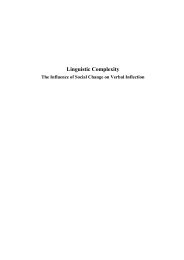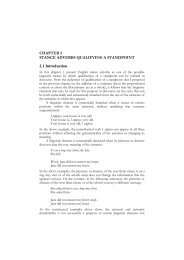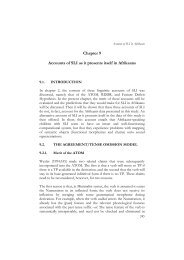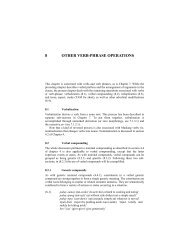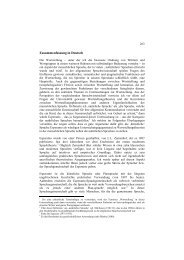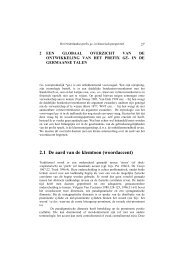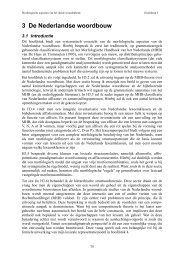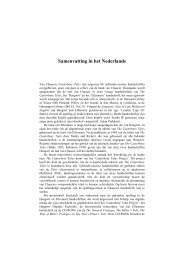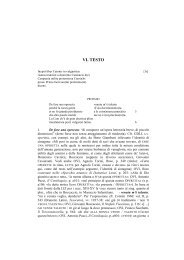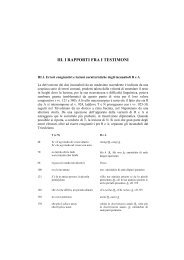Linking elements in compounds - LOT publications
Linking elements in compounds - LOT publications
Linking elements in compounds - LOT publications
Create successful ePaper yourself
Turn your PDF publications into a flip-book with our unique Google optimized e-Paper software.
SIMILARITY OF PLURAL ENDINGS AND LINKING ELEMENTS<br />
Trommelen, 1993, p. 402; Haeseryn et al., 1997, p. 683; Neijt & Zuidema, 1994,<br />
p. 69). Our study furthermore shows that the pronunciation of [(ə)n] for l<strong>in</strong>k<strong>in</strong>g<br />
en occurs <strong>in</strong> all regions of the Netherlands: No region was found to display a<br />
zero percentage of n-realization.<br />
As expected, greater n-realization was found for plural nouns than for<br />
<strong>compounds</strong> for most of the speakers <strong>in</strong> general. This is presumably due to the<br />
prosodic differences between the two constructions. In plural nouns, the en<br />
occurs <strong>in</strong> word f<strong>in</strong>al position and thus at a phonological phrase boundary. In<br />
<strong>compounds</strong>, the en occurs <strong>in</strong> word medial position and thus at only the<br />
prosodic word boundary. It is frequently assumed that greater f<strong>in</strong>al lengthen<strong>in</strong>g<br />
occurs <strong>in</strong> f<strong>in</strong>al syllables (Oller, 1973; Hofhuis et al., 1995), and this probably<br />
expla<strong>in</strong>s the greater n-realization for plural nouns than for <strong>compounds</strong>. 9<br />
In contrast to the claims of some l<strong>in</strong>guists who are not conv<strong>in</strong>ced that<br />
l<strong>in</strong>k<strong>in</strong>g en is related to the plural suffix -en (de Haas & Trommelen, 1993;<br />
Verkuyl, 2007), the present results show a strong correlation between the<br />
pronunciations of plural end<strong>in</strong>gs and l<strong>in</strong>k<strong>in</strong>g <strong>elements</strong> for different regions of<br />
the Netherlands: The regional speech variation that occurred <strong>in</strong> plural end<strong>in</strong>gs<br />
predicts the pronunciation variation <strong>in</strong> l<strong>in</strong>k<strong>in</strong>g <strong>elements</strong>. On the basis of our<br />
f<strong>in</strong>d<strong>in</strong>gs, we conclude that speakers from different regions of the Netherlands<br />
do not dist<strong>in</strong>guish between the l<strong>in</strong>k<strong>in</strong>g en and the plural -en <strong>in</strong> their speech<br />
9 An alternative explanation could be that speakers sometimes consider Dutch l<strong>in</strong>k<strong>in</strong>g en as a<br />
mean<strong>in</strong>gless element, not related to the plural suffix. In that case, one may expect our study to<br />
provide pairs of test items <strong>in</strong> which the compound is pronounced with [ə] and the correspond<strong>in</strong>g<br />
phrase with [(ə)n]. We took the data from region Middle as a sample to test this possible<br />
explanation and compared the pronunciations of pairs with l<strong>in</strong>k<strong>in</strong>g en and plural -en (e.g.,<br />
noot+en+kraker - noot+en kraken, ‗nutcracker - to crack nuts‘). The speakers of this region<br />
pronounced all item pairs most often identically (80% of all cases), except <strong>in</strong> a m<strong>in</strong>ority of cases:<br />
the l<strong>in</strong>k<strong>in</strong>g element pronounced as [ə] and the plural noun as [(ə)n] (14%) or reverse (6%). For<br />
the latter group (i.e., 20% of the cases <strong>in</strong> which the item pairs were pronounced differently), no<br />
item pair was found to be pronounced differently by most speakers. If the alternative explanation<br />
was true, one would expect a large number of speakers to pronounce the same item pair<br />
differently, which was not the case. Therefore, we consider a prosodic explanation for the<br />
difference <strong>in</strong> n-realization between plural end<strong>in</strong>gs and l<strong>in</strong>k<strong>in</strong>g <strong>elements</strong> to be more plausible here.<br />
47



